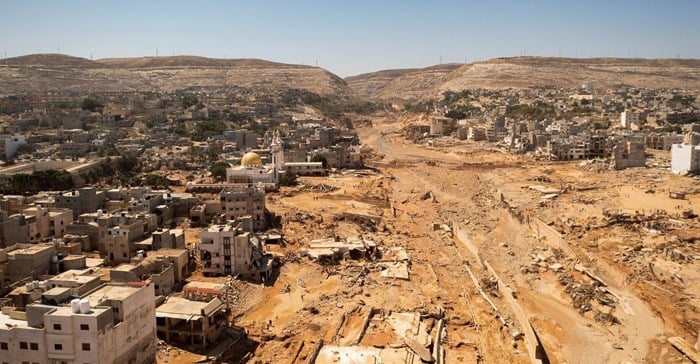
Top stories




What caused the flood?
After pummelling other Mediterranean countries, the powerful Storm Daniel swept into Libya at the weekend, unleashing record amounts of rain as it made landfall.
The rain dumped by the storm filled a normally dry riverbed, or wadi, in the hills south of Derna. The pressure was too much for two dams built to protect the city from floods. They collapsed, unleashing a torrent that ran through the city.
The head of the World Meteorological Organisation (WMO) said on Thursday that casualties could have been avoided if the divided country, shattered by some 12 years of conflict and chaos, had a functional weather service able to issue warnings.
In a research paper published last year, hydrologist Abdelwanees A. R. Ashoor of Libya's Omar Al-Mukhtar University said repeated flooding of the seasonal riverbed, or wadi, was a threat to Derna. He cited five floods since 1942 and called for immediate steps to ensure regular maintenance of the dams.
Large parts of the city - some officials say a quarter or more - have been wiped out. At least 30,000 people have been displaced, according to the UN migration agency.
The areas worst affected are along the banks of the wadi that cuts through the city centre. Embankments with whole neighbourhoods on top were destroyed or washed away. Infrastructure including the city's bridges have been destroyed.
The flood uprooted trees and wrecked hundreds of cars, many flipped on their sides or their roofs. Reuters journalists saw one vehicle wedged on the second floor balcony of a building. Much of the city is covered in mud.
Power and water supplies were severed after the flood. The UN Office for the Coordination of Humanitarian Affairs (OCHA) reported on Wednesday that electricity had been partially restored along with internet services.
Officials have given differing numbers of dead and missing, but all are in the thousands. In one of the largest tolls cited so far, mayor Abdulmenam Ghaithi told a broadcaster there could be 18,000 to 20,000 dead, based on the number of districts hit.
Hichem Abu Chkiouat, minister of civil aviation in the eastern administration, has told Reuters more than 5,300 dead have been counted so far, and the number was likely to increase significantly and might even double.
OCHA said on Wednesday estimates are at over 2,000 deaths and at least 5,000 people missing. The International Federation of the Red Cross and Red Crescent Societies (IFRC) said on Tuesday around 10,000 people were thought to be missing.
The damage done to infrastructure including roads and bridges is severely hampering relief efforts, with all three bridges in Derna destroyed, OCHA said.
Libyan officials have emphasised the need for search and rescue support, and rescue teams have arrived from Egypt, Tunisia, the United Arab Emirates, Turkey and Qatar.
Rescuers have appealed for more body bags. With large numbers of bodies yet to be recovered, Derna mayor Ghaithi has expressed fear of an epidemic.
Libyan officials say the country has never faced a catastrophe of this scale. But the response has been complicated by a fractured political situation.
Libya has been mired in conflict and chaos since 2011 when the longtime dictator Muammar Gaddafi was toppled in an uprising that split the North African state down the middle and spawned myriad rival militias competing for power.
Though Derna falls under the eastern administration, the western government based in Tripoli has sent aid to the city.

Reuters, the news and media division of Thomson Reuters, is the world's largest multimedia news provider, reaching billions of people worldwide every day.
Go to: https://www.reuters.com/